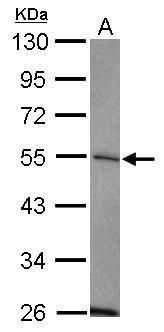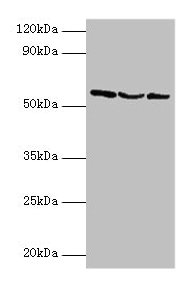USP14 antibody
GTX115186
ApplicationsWestern Blot, ImmunoHistoChemistry, ImmunoHistoChemistry Paraffin
Product group Antibodies
ReactivityHuman, Mouse, Rat
TargetUSP14
Overview
- SupplierGeneTex
- Product NameUSP14 antibody
- Delivery Days Customer9
- Application Supplier NoteWB: 1:500-1:3000. IHC-P: 1:100-1:1000. *Optimal dilutions/concentrations should be determined by the researcher.Not tested in other applications.
- ApplicationsWestern Blot, ImmunoHistoChemistry, ImmunoHistoChemistry Paraffin
- CertificationResearch Use Only
- ClonalityPolyclonal
- Concentration1 mg/ml
- ConjugateUnconjugated
- Gene ID9097
- Target nameUSP14
- Target descriptionubiquitin specific peptidase 14
- Target synonymsTGT, Ubp6, ubiquitin carboxyl-terminal hydrolase 14, deubiquitinating enzyme 14, tRNA-guanine transglycosylase, 60-kD subunit, ubiquitin specific peptidase 14 (tRNA-guanine transglycosylase), ubiquitin specific protease 14 (tRNA-guanine transglycosylase), ubiquitin thioesterase 14, ubiquitin thiolesterase 14, ubiquitin-specific processing protease 14
- HostRabbit
- IsotypeIgG
- Protein IDP54578
- Protein NameUbiquitin carboxyl-terminal hydrolase 14
- Scientific DescriptionThis gene encodes a member of the ubiquitin-specific processing (UBP) family of proteases that is a deubiquitinating enzyme (DUB) with His and Cys domains. This protein is located in the cytoplasm and cleaves the ubiquitin moiety from ubiquitin-fused precursors and ubiquitinylated proteins. Mice with a mutation that results in reduced expression of the ortholog of this protein are retarded for growth, develop severe tremors by 2 to 3 weeks of age followed by hindlimb paralysis and death by 6 to 10 weeks of age. Alternate transcriptional splice variants, encoding different isoforms, have been characterized. [provided by RefSeq]
- ReactivityHuman, Mouse, Rat
- Storage Instruction-20°C or -80°C,2°C to 8°C
- UNSPSC12352203
References
- Raz V, Raz Y, Paniagua-Soriano G, et al. Proteasomal activity-based probes mark protein homeostasis in muscles. J Cachexia Sarcopenia Muscle. 2017,8(5):798-807. doi: 10.1002/jcsm.12211Read this paper





